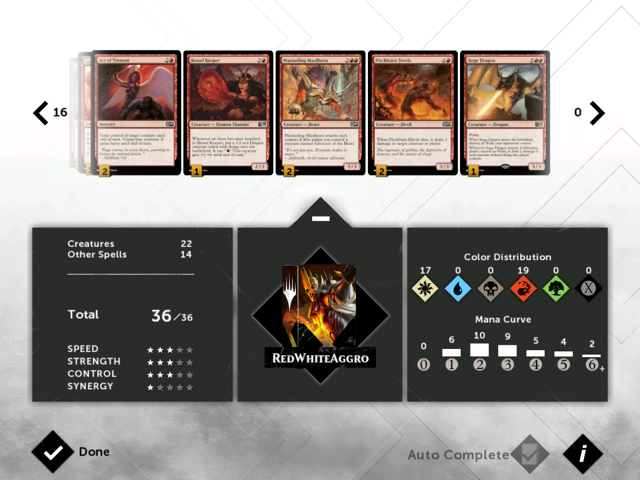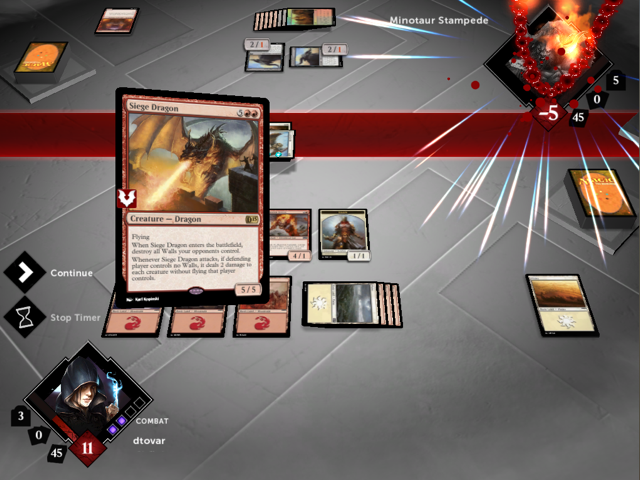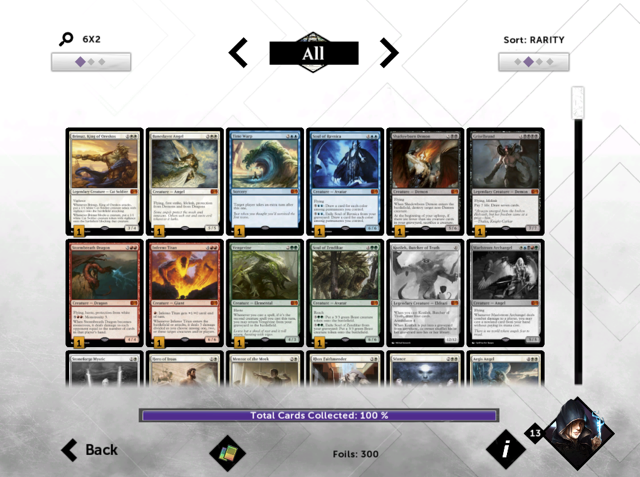Dear God, if any game can embody the saying “One step forward, two steps back”, its Magic 2015. While I want to love the game, I merely enjoy it in spite of all of its flaws. Things aren’t all bad and if Magic 2015 does one thing it gives hope for the future of the franchise.
The One Step Forward
The biggest thing that Magic 2015 did this year is add deck customization. I should mention that I have been a Magic: the Gathering player for 20 years now and have played in my fair share of tournaments, both constructed and limited (for those that don’t know what those two types of formats mean, just know that I’ve played a ton and built plenty of decks). So, of course, the deck builder in me was pumped to see an affordable way to play Magic with the ability to build plenty of degenerate decks.
The deck building interface is solid enough, though it does leave a few things to be desired. To build a deck, you simply choose the cards from your collection, throw them into the deck and decide if you want to let the AI add lands or do it on your own (you’ll need to enable that in the options menu, which the player is never informed about).

You will find options ranging from rarity to color filtering which can help you with coming up with ideas. You can also filter spells – by type, creatures – not by type, and enchantments. This makes it easier to ensure your deck has the number of spells and creatures you want, but the lack of sorting by creature type is a major flaw.
From my 24 hours or so of playing online I have seen a wide variety of decks with a constantly shifting meta game. At one point a red and white rush deck was popular, then I quickly saw a mill deck take over. Again, if you don’t know what these terms mean, just know that there is plenty of variety in the deck building and you will see a wide variety of decks online.
Deck building also prevents players from getting too degenerate with their builds by enforcing a rarity limit. You can have 1 copy of any number of mythics, 2 copies of any number of rares, 3 copies of any number of uncommons and 4 copies of any number of commons. While that sounds like a bit of a harsh limit, know that it is actually a very solid way to control the deck power levels. This is a very good point because Magic 2015 is targeted towards a more inexperienced, or at least casual, type of player.
The Two (at least) Steps Back
I wish the step forward was the longer section of the review, but I don’t think I could get wordy enough to make that happen. First, know that the game is fun, so take this part of the review as a series of complaints to help you decide just how much you can handle in a game before you find a deal breaker.
First, deck building comes up with some short falls. This has more to do with the card selection currently in the game (about 300 cards total). There are plenty of cards that have a theme just calling out for a sweet deck to be built around them. For example, the heroic ability allows cards to get a bonus (temporary or permanent depending on the card) when they are targeted by a spell. In paper Magic this is a fantastic archetype in some drafts as you can build a large number of creatures with the ability and back them up with spells to pump them more. In Magic 2015 there are only few (3 I think) cards that include this keyword. To make matters worse, there are very few cards in the color that are actually good enough to secure a spot in your deck.
Next, the user interface only works well on tablet devices. While it is atrocious on computers with a mouse and keyboard, it is serviceable with a controller. It is far from great and a huge step back from Magic 2014’s UI, but it likely won’t be a deal breaker for most. My best advice for PC users is to get a cheap controller and use that to play. You can get past most of the issues in time, but it is far from an ideal layout for a mouse and keyboard.
Multiplayer has taken a huge step backwards, possibly adding another step, from every other version of Duels of the Planeswalkers released in the past. The biggest issue has to do with the lack of a real lobby system. After each game you are kicked back out to relaunch. If you set a game to private, you have to reset it when you launch the next game. If you launch a game that you plan to invite a friend to, be fast to set the private rule, otherwise you will have to kick some random player out of the game as well.
Two headed giant is gone from this version of the game. This is one of the few times that I will mention the fan out lash in a review, but it has been a very sore point for most fans of the series. While two headed giant is a fantastic co-op option for the game, there are a few reasons that it was rightfully not included. First, two headed giant has you and a friend playing on the same team against another group of two players. You both take your turn at the same time and depending on the version you have a shared line of blocking creatures. Other versions treat your creatures individually and you can’t block for your ally. You also have a shared life pool. The fun part about this particular option is the communication that is required to make massive plays that can turn the game around.
So, why was two headed giant removed from the game? From my experience, two headed giant games can be extremely degenerate and broken if someone builds both decks to work together. For example, I could play a deck that only benefits from life gain, but play no life gain cards at all. My partner could play only cards that gain life and now we have two decks that are going to be all but impossible to handle by those without a constant gaming partner. Some combos would actually make the game last just a few turns.
One final little issue concerns lands in general. The AI is terrible at tapping lands this time around. Previous versions of the series had the AI intelligently tapping land for you, this time around it seems to take no consideration of what is left in your hand. It won’t be a major problem once you get used to tapping on your own but it sucks for a while. There is also an issue with knowing what color of lands you have out when you have multi-colored lands. There is no easy way to count them up when you are searching your library for a card or land. You just have to memorize it.
A Leap Backwards
The base game is $10 and you can unlock a majority of the cards for free. If you want foil cards you need to pay a premium, $8 bucks to make all your cards foil, and they only add foil to the card itself. This may sound like a non-issue but as a long time Magic: the Gathering Online player, I expect my spells that produce tokens to produce foil tokens if the main card is also foil. Not the case in Magic 2015. You also have no control over the shiny aspects of your land. If I spend $18 bucks for the game and a foil bonus for my cards, I expect every single card I play to shine like a diamond.
Here is the biggest issue with the game though. I actually argued that this wasn’t a big deal at first, but after some time building decks and testing, I have changed my view. To unlock the additional 40 premium cards you will need to pay $24 dollars or so. This is ludicrous in every aspect of the word. The big issue is that the 40 cards offered for the premium price are actually necessary to build many of the decks that other cards hint at. To compete online, you get a huge edge with the premium cards.
Now you are looking at your yearly $10 game coming up to over $40 bucks and that is before they add more premium cards, more expansions that require a purchase (as well as the purchase of more foil stickers for those cards) and whatever else they decide to add to the price tag. Originally the Duels of the Planeswalkers series was a cheap alternative to Magic. It let players get in and learn the game, get hooked, then go to a store and play with the paper cards. Now Stainless Steel Games and Wizards of the Coast are asking you for a huge investment upfront for a game that used to cost much less. I don’t mind the price on the foil stickers, but when you hover cards over my face, that are actually giving me an edge in the competitive realm, you are going to be hard pressed to get anything from me on the next installment.
The Wrap Up
Magic 2015 is a fun game with some huge flaws. I know that people often do not read an entire review and just rush to the score, and generally the summary, so I ask that you keep this in mind when looking at the score for the game. Magic 2015 scores 3 points higher than it would otherwise just because it is Magic. The game it is based around, the paper version, is a fantastic game, one of the best card games ever made. That makes it hard to give the game the score it truly deserves. It would be like putting the greatest cheese in the world on some $1 bread when making a grilled cheese sandwich. The sandwich suffers, but damn that cheese is good.



